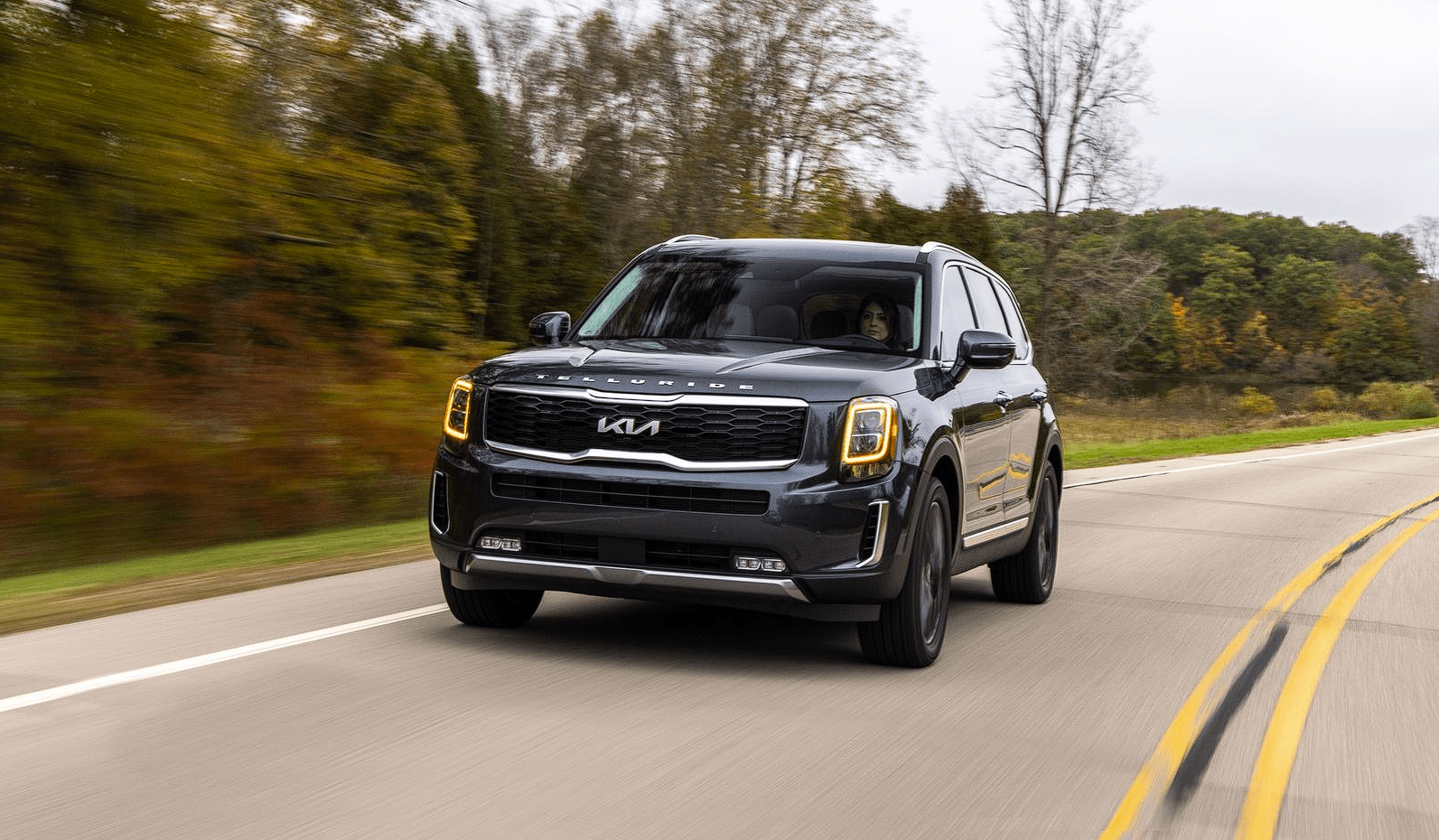2022 Kia Telluride Navigation-Based Smart Cruise Control and Lane Following Assist
With its Navigation-Based Smart Cruise Control (NSCC) and Lane Following Assist (LFA) systems, the 2022 Kia Telluride offers a cutting-edge driving experience. This shows that Kia is dedicated to changing driver comfort and safety. NSCC uses GPS and map data to turn regular cruise control into a dynamic, anticipatory system that changes the car’s speed in reaction to things that might happen on the road, like curves, intersections, and changes in the speed limit. In addition, LFA uses a variety of sensors and cameras to keep an eye on the lane lines and make sure the Telluride stays in its lane, turning gently when needed. This well-balanced mix of technologies not only makes driving easier on long highway trips and in different traffic conditions, but it also gives drivers more confidence and comfort behind the wheel, making the 2022 Kia Telluride the most advanced SUV on the market.
2023 Kia Telluride Specs, Price, Features and Mileage (Brochure)
Navigation-based Smart Cruise Control (NSCC)
Navigation-based Smart Cruise Control will help automatically adjust vehicle speed when driving on highways (or motorways) with speed limits by using road information from the navigation system while Smart Cruise Control is operating.
NOTICE
- Navigation-based Smart Cruise Control is available only on controlled access road of certain highways.
- * Controlled access road indicates roads with limited entrances and exits that allow uninterrupted high-speed traffic flow. Only passenger cars and motorcycles are allowed on controlled access roads.
- Additional highways may be expanded by future navigation updates.
NOTICE
Navigation-based Smart Cruise Control operates on main roads of highways (or motorways), and does not operate on interchanges or junctions.
Highway Auto Curve Slowdown
If vehicle speed is high, the Highway Auto Curve Slowdown function will temporarily decelerate your vehicle to help you drive safely on a curve, based on the curve information from the navigation.
Navigation-based Smart Cruise Control Settings
Setting features
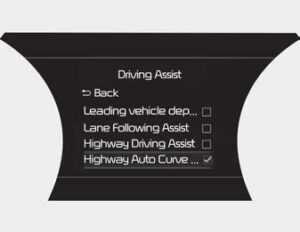
Highway Auto Curve Slowdown
- With the ENGINE START/STOP button in the ON position, press the MODE button ( ) several times on the steering wheel until the User Settings menu appears on the
LCD display. Select Driver Assistance → Driving Assist → Highway Auto Curve Slowdown from the settings menu to set whether or not to use each function.
NOTICE
When there is a problem with Navigation-based Smart Cruise Control, the function cannot be set from the settings menu.
Navigation-based Smart Cruise Control Operation
Operating conditions
Navigation-based Smart Cruise Control is ready to operate if all of the following conditions are satisfied:
- Smart Cruise Control is operating
- Driving on main roads of highways (or motorways)
Display and control
When Navigation-based Smart Cruise Control operates, it will be displayed on the cluster as follows:
Navigation-based Smart Cruise Control standby
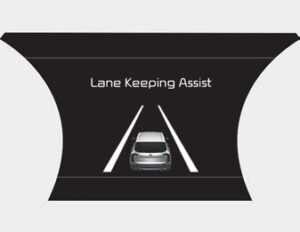
If the operating conditions are satisfied, the white ( ) symbol will illuminate.
Navigation-based Smart Cruise Control operating

If temporary deceleration is required in the standby state and Navigation-based Smart Cruise Control is operating, the green ) symbol will illuminate on the cluster.
WARNING
‘Drive carefully’ warning message will appear in the following circumstances:
- Navigation-based Smart Cruise Control is not able to slow down your vehicle to a safe speed.
NOTICE
Highway Auto Curve Slowdown uses the same ( ) symbol.
Highway Auto Curve Slowdown
- Depending on the curve ahead on the highway (or motorway), the vehicle will decelerate, and after passing the curve, the vehicle will accelerate to the Smart Cruise Control set speed.
- Vehicle deceleration time may differ depending on the vehicle speed and the degree of the curve on the road. The higher the driving speed, the faster the vehicle will decelerate.
Limitations of Navigation-based Smart Cruise Control
Navigation-based Smart Cruise Control may not operate normally under the following circumstances:
- The navigation is not working properly.
- The navigation is not updated to include the latest information about road curvature and changes.
- Speed limit and road information in the navigation is not updated
- The map information and the actual road is different because of real-time GPS data or map information error
- The navigation searches for a route while driving
- GPS signals are blocked in areas such as tunnel
- A road that divides into two or more roads and joins again
- The driver goes off course the route set in the navigation
- The route to the destination is changed or canceled by resetting the navigation (including TPEG change)
- The navigation cannot detect the current vehicle position (ex: elevated roads including overpasses adjacent to general roads or nearby roads exist in a parallel way)
- The vehicle enters a service station or rest area
- The speed limit of some sections changes depending on the road situations
- Android Auto or Car Play is operating
- The navigation is being updated v
- The navigation is being restarted while driving
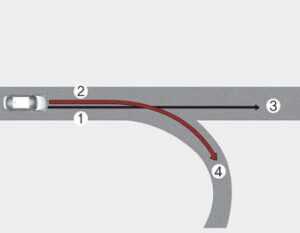
[1]: Driving route, [2]: Set route, [3]: Main road, [4]: Branch line
- between the navigation set route (branch line) and the driving route (main road), Highway Auto Curve Slowdown function may not operate until the driving route is recognized as the main road.
- When there is a difference recognized as the main road by maintaining the main road instead of the navigation set route, High-way Auto Curve Slowdown func-tion will operate. Depending on the distance to the curve and the current vehicle speed, vehicle deceleration may not be sufficient or may decelerate rapidly.
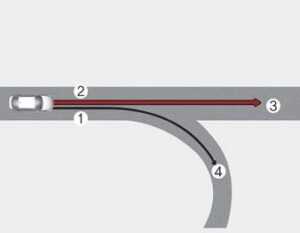
[1]: Driving route, [2]: Main road, [3]: Set route, [4]: Branch line
- When there is a difference between the navigation route (main road) and the driving route (branch line), Highway Auto Curve Slowdown function may temporarily operate due to the navigation information of the highway curve section.
- When it is judged that you are driving out of the route by entering the highway interchange and junction, Highway Auto Curve Slowdown function will not operate.

[1]: Driving route, [2]: Main road, [3]: Branch line
- If there is no destination set on the navigation, the Highway Auto Curve Slowdown function will operate based on the curve information on the main road.
- Even if you depart from the main road, the Highway Auto Curve Slow-down function may temporarily operate due to navigation information of the highway curve section.
WARNING
- Navigation-based Smart Cruise Control is not a substitute for safe driving practices, but a convenience function. Always have your eyes on the road, and it is the responsibility of the driver to avoid violating traffic laws.
- The navigation’s speed limit information may differ from the actual speed limit information on the road. It is the driver’s responsibility to check the speed limit on the actual driving road or lane.
- Highway Auto Curve Slowdown will automatically cancel when you leave the main road of the highway. Always pay attention to the road and driving conditions while driving.
- Navigation-based Smart Cruise Control may not operate due to the existence of leading vehicles and the driving conditions of the vehicle. Always pay attention to road and driving conditions while driving.
- When you are towing a trailer or another vehicle, we recommend that Navigation-based Smart Cruise Control is turned off due to safety reasons.
- After you pass through a tollgate on a highway, Navigation-based Smart Cruise Control operates based on the first lane. If you enter one of the other lanes, the function might not properly decelerate.
- The vehicle will accelerate if the driver depresses the accelerate pedal while the Navigation-based Smart Cruise Control is operating, and the function will not decelerate the vehicle. However, if the accelerator pedal is insufficiently depressed, the vehicle may slow down.
- If the driver accelerates and releases the accelerator pedal while Navigation-based Smart Cruise Control is operating, the vehicle may not decelerate sufficiently or may rapidly decelerate to a safe speed.
- If the curve is too large or too small, Navigation-based Smart Cruise Control may not operate.
NOTICE
- When the function is activated, the vehicle decelerates automatically before reaching the curved road according to its curvature, and the driving speed returns to the speed set by Smart Cruise Control after passing the curved section.
- The speed information on the cluster and navigation may differ
- A time gap could occur between the navigation’s guidance and when Navigation-based Smart Cruise Control operation starts and ends.
- Even if you are driving at a speed lower than the Smart Cruise Control set speed, acceleration may be limited by curve sections ahead.
- If Navigation-based Smart Cruise Control is operating while leaving the main road to enter an inter-change, junction, rest area, etc., the function may operate for a certain period of time.
- Deceleration by Navigation-based Smart Cruise Control may not be sufficient due to road conditions such as uneven road surfaces, narrow lanes, etc.
Lane Following Assist (LFA)
Lane Following Assist is designed to detect lane markings or vehicles on the road, and assists the driver’s steering to help keep the vehicle between lanes.
NOTICE
LFA stands for Lane Following Assist.
Detecting sensor
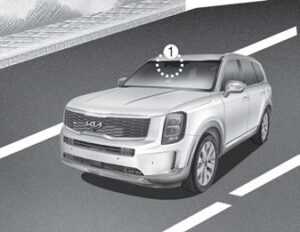
[1]: Front view camera
The front view camera is used as a detecting sensor to detect lane markings and front vehicles. Refer to the picture above for the detailed location of the detecting sensor.
2023 Kia Telluride Specs, Price, Features and Mileage (Brochure)
Lane Following Assist Settings
Setting features
Turning Lane Following Assist ON/OFF

With the ENGINE START/STOP button in the ON position, press the MODE button ( ) several times on the steering wheel until User Settings menu appears on the LCD display. Select Driver Assistance → Driving Assist → Lane Following Assist from the settings menu to set whether or not to use each function.
Warning Volume
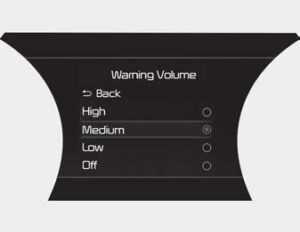
With the ENGINE START/STOP button in the ON position, press the MODE button ( ) several times on the steering wheel until User Settings menu appears on the LCD display. Select Driver Assistance → Warning Volume to change the warning volume to High, Medium, Low or Off for Lane Following Assist. If you change the Warning Volume, the Warning Volume of other Driver Assistance systems may change.
Lane Following Assist Operation
Warning and Control
Lane Following Assist
If the vehicle ahead or both lane markings are detected and your vehicle speed is below 95 mph (153 km/h), the green ( ) indicator light will illuminate on the cluster, and the function will help the vehicle stay in lane by controlling the steering wheel.
CAUTION
When the steering wheel is not controlled, the green ( ) indicator light will blink and change to white.
Hands-off warning
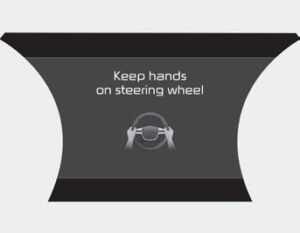
If the driver takes their hands off the steering wheel for several seconds, the ‘Keep hands on steering wheel’ warning message will appear and an audible warning will sound in stages.
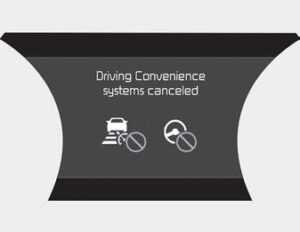
If the driver still does not have their hands on the steering wheel after the hands-off warning, the Driving Convenience Systems canceled warning message will appear and Lane Following Assist will be automatically canceled.
WARNING
- The steering wheel may not be assisted if the steering wheel is held very tight or the steering wheel is steered over a certain degree.
- Lane Following Assist does not operate at all times. It is the responsibility of the driver to safely steer the vehicle and to maintain the vehicle in its lane.
- The hands-off warning message may appear late depending on road conditions. Always have your hands on the steering wheel while driving.
- If the steering wheel is held very lightly the hands-off warning message may appear because the function may not recognize that the driver has their hands on the steering wheel.
- If you attach objects to the steering wheel, the hands-off warning may not work properly.
Lane undetected
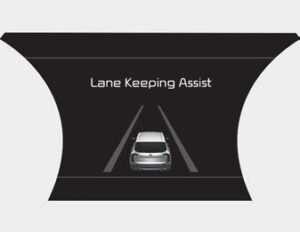
Lane detected

- If lane markings are not detected, steering wheel control by Lane Following Assist can be limited depending on whether a vehicle is in front or the driving conditions of the vehicle.
- Even though the steering is assisted by Lane Following Assist, the driver may control the steering wheel.
- The steering wheel may feel heavier or lighter when the steering wheel is assisted by the function than when it is not.
Lane Following Assist Malfunction and Limitations
Lane Following Assist malfunction

When Lane Following Assist is not working properly, the ‘Check Lane Following Assist (LFA) system’ warning message will appear on the cluster (turns off after a certain time) and the ( ) warning light will illuminate. In this case, have the function checked by an authorized Kia dealer.
FAQ
Navigation-Based Smart Cruise Control is an advanced cruise control system that utilizes GPS and map data to adjust the vehicle’s speed automatically based on the road ahead.
NSCC differs from traditional cruise control by using navigation data to anticipate changes in road conditions, such as curves, junctions, and speed limit variations.
Yes, the driver can typically set a specific following distance to maintain from the vehicle ahead using NSCC.
Yes, NSCC relies on GPS and map data to provide information about upcoming road features and changes.
Lane Following Assist is a driver assistance system that helps keep the vehicle centered within its lane by providing steering inputs as needed.
LFA uses cameras and sensors to monitor lane markings and the vehicle’s position within the lane. It then provides gentle steering assistance to help keep the vehicle in the center of the lane.
Yes, the driver can typically override LFA’s steering inputs by applying sufficient force to the steering wheel, allowing for manual control.
LFA is designed to work on a variety of road types, including highways and city streets, to assist with lane-keeping.
NSCC and LFA collectively enhance driver convenience by reducing the need for constant speed and steering adjustments during long highway journeys and in various traffic conditions.
Yes, NSCC and LFA can typically operate independently, but they can also work together to provide a more comprehensive driving experience.
The effectiveness of these systems may be affected by factors such as poor road markings, inclement weather, or rapid changes in road conditions.
While NSCC and LFA significantly reduce the risk of accidents related to lane-keeping and adaptive cruise control, they may not prevent all such incidents, especially in extreme situations or circumstances beyond their capabilities.
Yes, it is typically recommended for the driver to keep their hands on the steering wheel and remain attentive while using NSCC and LFA.
The availability of NSCC and LFA may vary depending on the trim level and options chosen.
The Telluride often includes a comprehensive suite of safety features, including blind-spot monitoring, lane-keeping assist, forward collision warning, and more, to enhance overall safety and driver assistance.
Useful Link
View Full User Guide: Kia Telluride 2022 User Guide
Download Manuals: https://owners.kia.com/content/owners/en/manuals.html
2023 Kia Telluride Specs, Price, Features and Mileage (Brochure)

